Capital Gain Tax Consequences on Sale of Collectibles and Income from Personal Exertion
VerifiedAdded on 2022/11/11
|9
|2309
|235
AI Summary
This document discusses the assessment of capital gain tax consequences accrued from the sale of collectibles and income from personal exertion. It also covers the loan amount repaid with an additional 5% upon the same and whether it will be considered as assessable as the taxable income of Patrick.
Contribute Materials
Your contribution can guide someone’s learning journey. Share your
documents today.
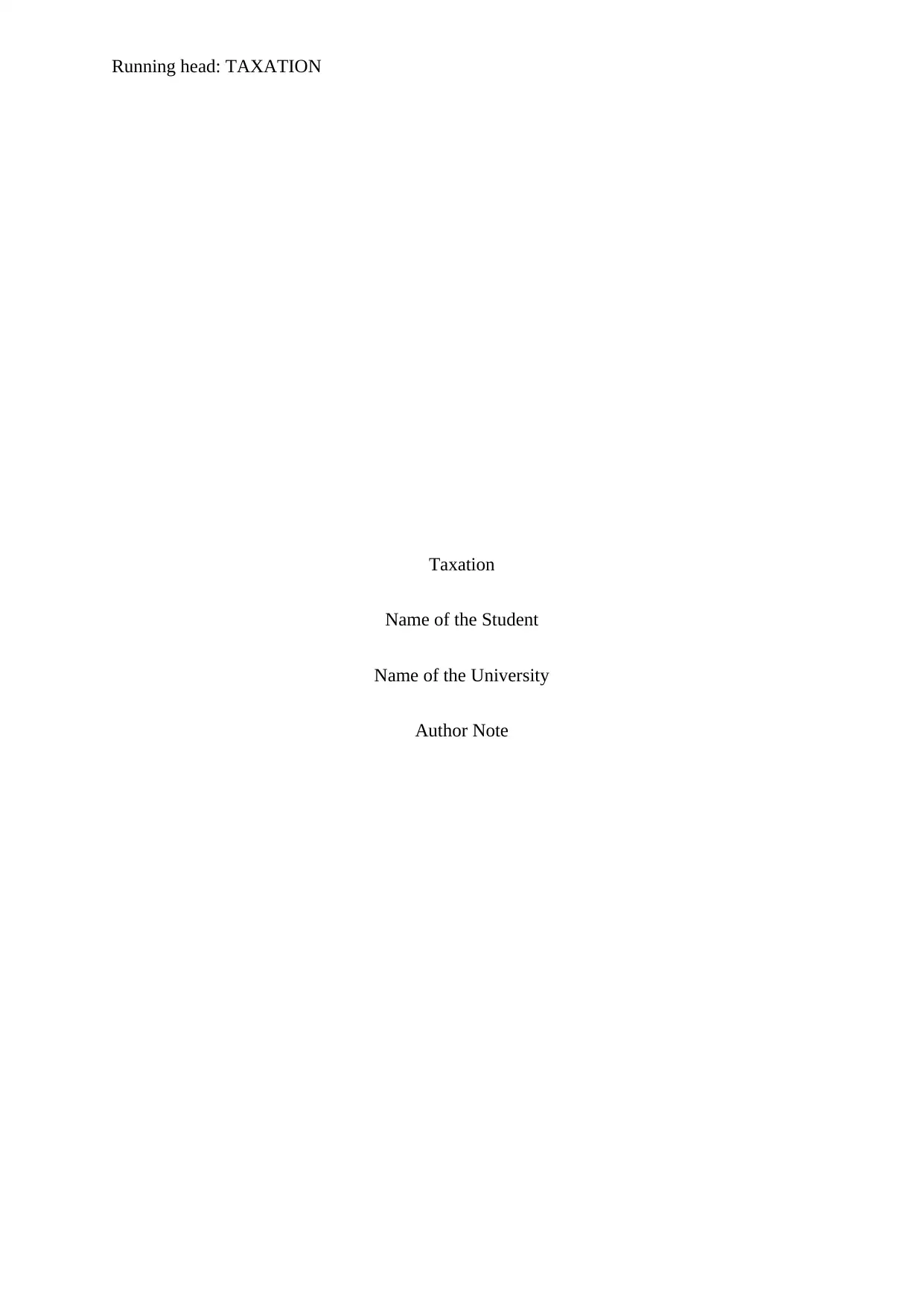
Running head: TAXATION
Taxation
Name of the Student
Name of the University
Author Note
Taxation
Name of the Student
Name of the University
Author Note
Secure Best Marks with AI Grader
Need help grading? Try our AI Grader for instant feedback on your assignments.
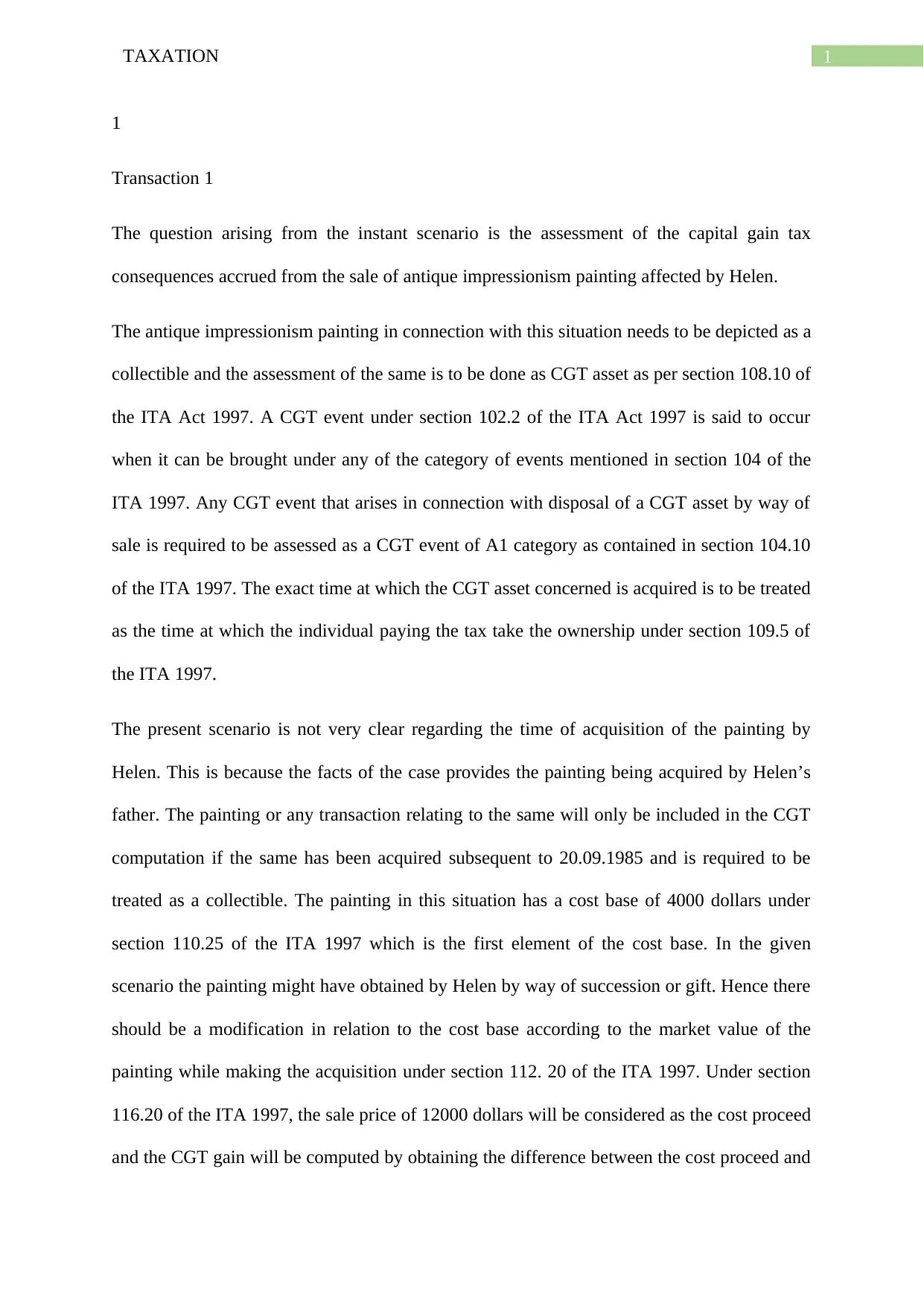
1TAXATION
1
Transaction 1
The question arising from the instant scenario is the assessment of the capital gain tax
consequences accrued from the sale of antique impressionism painting affected by Helen.
The antique impressionism painting in connection with this situation needs to be depicted as a
collectible and the assessment of the same is to be done as CGT asset as per section 108.10 of
the ITA Act 1997. A CGT event under section 102.2 of the ITA Act 1997 is said to occur
when it can be brought under any of the category of events mentioned in section 104 of the
ITA 1997. Any CGT event that arises in connection with disposal of a CGT asset by way of
sale is required to be assessed as a CGT event of A1 category as contained in section 104.10
of the ITA 1997. The exact time at which the CGT asset concerned is acquired is to be treated
as the time at which the individual paying the tax take the ownership under section 109.5 of
the ITA 1997.
The present scenario is not very clear regarding the time of acquisition of the painting by
Helen. This is because the facts of the case provides the painting being acquired by Helen’s
father. The painting or any transaction relating to the same will only be included in the CGT
computation if the same has been acquired subsequent to 20.09.1985 and is required to be
treated as a collectible. The painting in this situation has a cost base of 4000 dollars under
section 110.25 of the ITA 1997 which is the first element of the cost base. In the given
scenario the painting might have obtained by Helen by way of succession or gift. Hence there
should be a modification in relation to the cost base according to the market value of the
painting while making the acquisition under section 112. 20 of the ITA 1997. Under section
116.20 of the ITA 1997, the sale price of 12000 dollars will be considered as the cost proceed
and the CGT gain will be computed by obtaining the difference between the cost proceed and
1
Transaction 1
The question arising from the instant scenario is the assessment of the capital gain tax
consequences accrued from the sale of antique impressionism painting affected by Helen.
The antique impressionism painting in connection with this situation needs to be depicted as a
collectible and the assessment of the same is to be done as CGT asset as per section 108.10 of
the ITA Act 1997. A CGT event under section 102.2 of the ITA Act 1997 is said to occur
when it can be brought under any of the category of events mentioned in section 104 of the
ITA 1997. Any CGT event that arises in connection with disposal of a CGT asset by way of
sale is required to be assessed as a CGT event of A1 category as contained in section 104.10
of the ITA 1997. The exact time at which the CGT asset concerned is acquired is to be treated
as the time at which the individual paying the tax take the ownership under section 109.5 of
the ITA 1997.
The present scenario is not very clear regarding the time of acquisition of the painting by
Helen. This is because the facts of the case provides the painting being acquired by Helen’s
father. The painting or any transaction relating to the same will only be included in the CGT
computation if the same has been acquired subsequent to 20.09.1985 and is required to be
treated as a collectible. The painting in this situation has a cost base of 4000 dollars under
section 110.25 of the ITA 1997 which is the first element of the cost base. In the given
scenario the painting might have obtained by Helen by way of succession or gift. Hence there
should be a modification in relation to the cost base according to the market value of the
painting while making the acquisition under section 112. 20 of the ITA 1997. Under section
116.20 of the ITA 1997, the sale price of 12000 dollars will be considered as the cost proceed
and the CGT gain will be computed by obtaining the difference between the cost proceed and
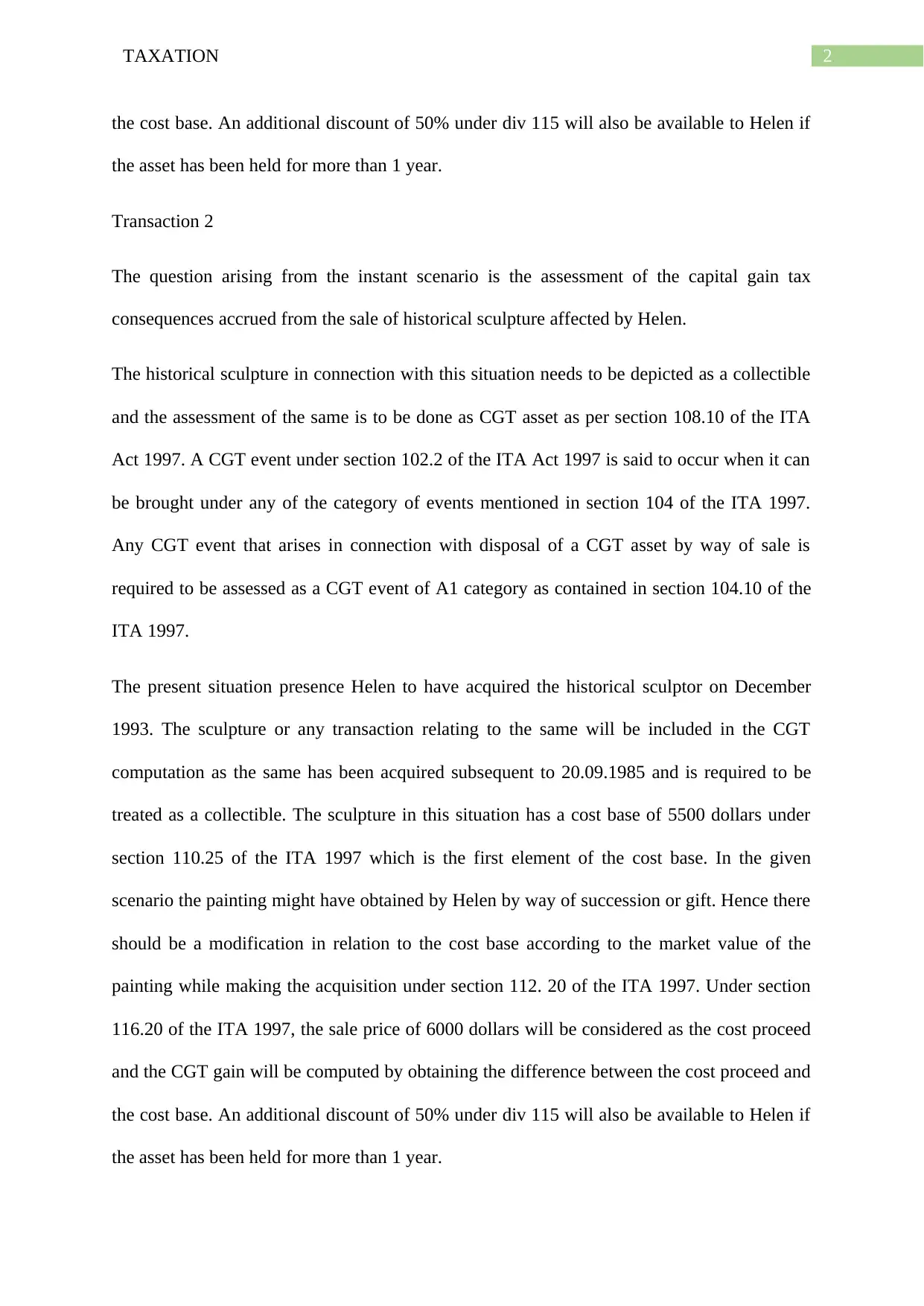
2TAXATION
the cost base. An additional discount of 50% under div 115 will also be available to Helen if
the asset has been held for more than 1 year.
Transaction 2
The question arising from the instant scenario is the assessment of the capital gain tax
consequences accrued from the sale of historical sculpture affected by Helen.
The historical sculpture in connection with this situation needs to be depicted as a collectible
and the assessment of the same is to be done as CGT asset as per section 108.10 of the ITA
Act 1997. A CGT event under section 102.2 of the ITA Act 1997 is said to occur when it can
be brought under any of the category of events mentioned in section 104 of the ITA 1997.
Any CGT event that arises in connection with disposal of a CGT asset by way of sale is
required to be assessed as a CGT event of A1 category as contained in section 104.10 of the
ITA 1997.
The present situation presence Helen to have acquired the historical sculptor on December
1993. The sculpture or any transaction relating to the same will be included in the CGT
computation as the same has been acquired subsequent to 20.09.1985 and is required to be
treated as a collectible. The sculpture in this situation has a cost base of 5500 dollars under
section 110.25 of the ITA 1997 which is the first element of the cost base. In the given
scenario the painting might have obtained by Helen by way of succession or gift. Hence there
should be a modification in relation to the cost base according to the market value of the
painting while making the acquisition under section 112. 20 of the ITA 1997. Under section
116.20 of the ITA 1997, the sale price of 6000 dollars will be considered as the cost proceed
and the CGT gain will be computed by obtaining the difference between the cost proceed and
the cost base. An additional discount of 50% under div 115 will also be available to Helen if
the asset has been held for more than 1 year.
the cost base. An additional discount of 50% under div 115 will also be available to Helen if
the asset has been held for more than 1 year.
Transaction 2
The question arising from the instant scenario is the assessment of the capital gain tax
consequences accrued from the sale of historical sculpture affected by Helen.
The historical sculpture in connection with this situation needs to be depicted as a collectible
and the assessment of the same is to be done as CGT asset as per section 108.10 of the ITA
Act 1997. A CGT event under section 102.2 of the ITA Act 1997 is said to occur when it can
be brought under any of the category of events mentioned in section 104 of the ITA 1997.
Any CGT event that arises in connection with disposal of a CGT asset by way of sale is
required to be assessed as a CGT event of A1 category as contained in section 104.10 of the
ITA 1997.
The present situation presence Helen to have acquired the historical sculptor on December
1993. The sculpture or any transaction relating to the same will be included in the CGT
computation as the same has been acquired subsequent to 20.09.1985 and is required to be
treated as a collectible. The sculpture in this situation has a cost base of 5500 dollars under
section 110.25 of the ITA 1997 which is the first element of the cost base. In the given
scenario the painting might have obtained by Helen by way of succession or gift. Hence there
should be a modification in relation to the cost base according to the market value of the
painting while making the acquisition under section 112. 20 of the ITA 1997. Under section
116.20 of the ITA 1997, the sale price of 6000 dollars will be considered as the cost proceed
and the CGT gain will be computed by obtaining the difference between the cost proceed and
the cost base. An additional discount of 50% under div 115 will also be available to Helen if
the asset has been held for more than 1 year.
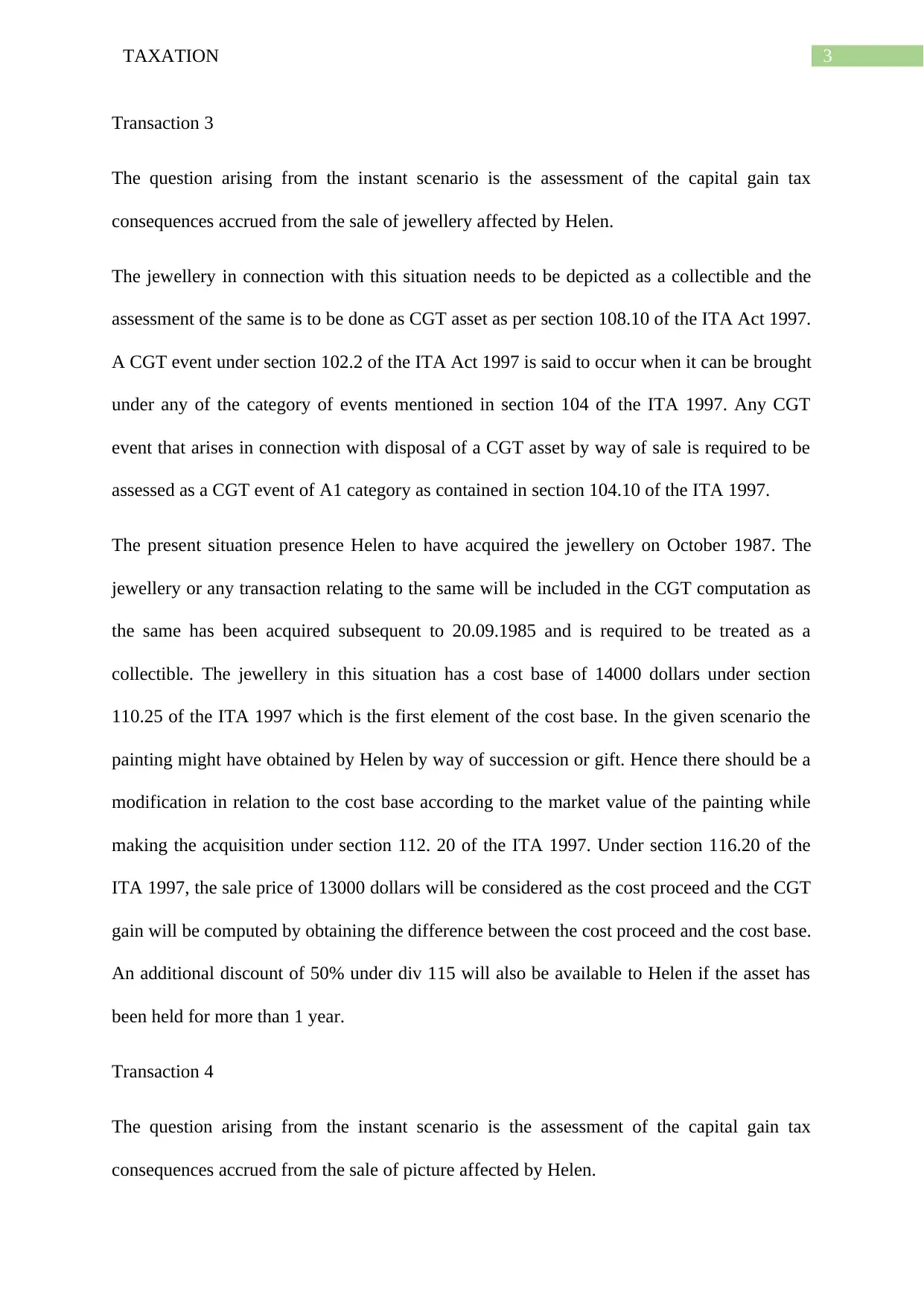
3TAXATION
Transaction 3
The question arising from the instant scenario is the assessment of the capital gain tax
consequences accrued from the sale of jewellery affected by Helen.
The jewellery in connection with this situation needs to be depicted as a collectible and the
assessment of the same is to be done as CGT asset as per section 108.10 of the ITA Act 1997.
A CGT event under section 102.2 of the ITA Act 1997 is said to occur when it can be brought
under any of the category of events mentioned in section 104 of the ITA 1997. Any CGT
event that arises in connection with disposal of a CGT asset by way of sale is required to be
assessed as a CGT event of A1 category as contained in section 104.10 of the ITA 1997.
The present situation presence Helen to have acquired the jewellery on October 1987. The
jewellery or any transaction relating to the same will be included in the CGT computation as
the same has been acquired subsequent to 20.09.1985 and is required to be treated as a
collectible. The jewellery in this situation has a cost base of 14000 dollars under section
110.25 of the ITA 1997 which is the first element of the cost base. In the given scenario the
painting might have obtained by Helen by way of succession or gift. Hence there should be a
modification in relation to the cost base according to the market value of the painting while
making the acquisition under section 112. 20 of the ITA 1997. Under section 116.20 of the
ITA 1997, the sale price of 13000 dollars will be considered as the cost proceed and the CGT
gain will be computed by obtaining the difference between the cost proceed and the cost base.
An additional discount of 50% under div 115 will also be available to Helen if the asset has
been held for more than 1 year.
Transaction 4
The question arising from the instant scenario is the assessment of the capital gain tax
consequences accrued from the sale of picture affected by Helen.
Transaction 3
The question arising from the instant scenario is the assessment of the capital gain tax
consequences accrued from the sale of jewellery affected by Helen.
The jewellery in connection with this situation needs to be depicted as a collectible and the
assessment of the same is to be done as CGT asset as per section 108.10 of the ITA Act 1997.
A CGT event under section 102.2 of the ITA Act 1997 is said to occur when it can be brought
under any of the category of events mentioned in section 104 of the ITA 1997. Any CGT
event that arises in connection with disposal of a CGT asset by way of sale is required to be
assessed as a CGT event of A1 category as contained in section 104.10 of the ITA 1997.
The present situation presence Helen to have acquired the jewellery on October 1987. The
jewellery or any transaction relating to the same will be included in the CGT computation as
the same has been acquired subsequent to 20.09.1985 and is required to be treated as a
collectible. The jewellery in this situation has a cost base of 14000 dollars under section
110.25 of the ITA 1997 which is the first element of the cost base. In the given scenario the
painting might have obtained by Helen by way of succession or gift. Hence there should be a
modification in relation to the cost base according to the market value of the painting while
making the acquisition under section 112. 20 of the ITA 1997. Under section 116.20 of the
ITA 1997, the sale price of 13000 dollars will be considered as the cost proceed and the CGT
gain will be computed by obtaining the difference between the cost proceed and the cost base.
An additional discount of 50% under div 115 will also be available to Helen if the asset has
been held for more than 1 year.
Transaction 4
The question arising from the instant scenario is the assessment of the capital gain tax
consequences accrued from the sale of picture affected by Helen.
Secure Best Marks with AI Grader
Need help grading? Try our AI Grader for instant feedback on your assignments.
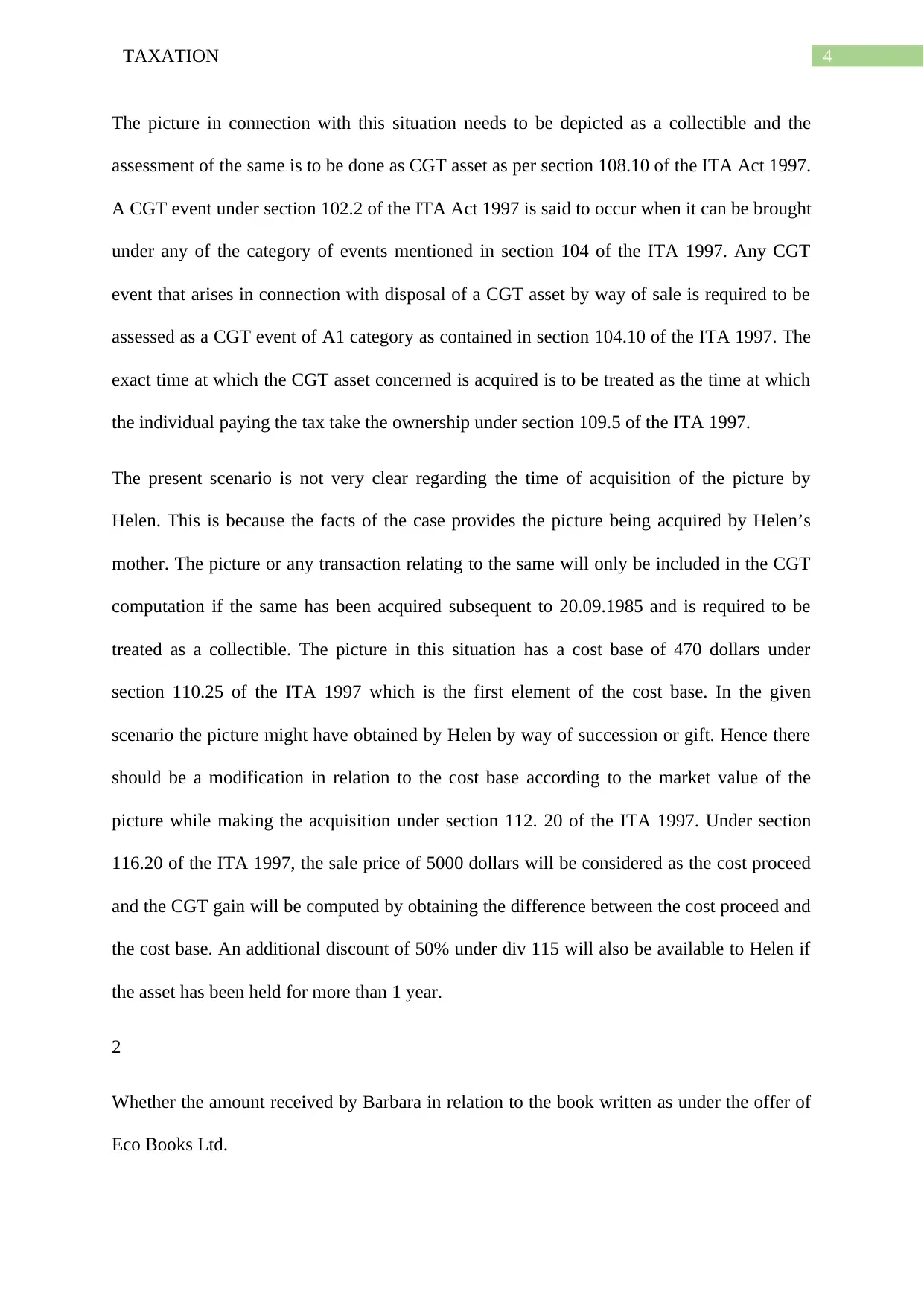
4TAXATION
The picture in connection with this situation needs to be depicted as a collectible and the
assessment of the same is to be done as CGT asset as per section 108.10 of the ITA Act 1997.
A CGT event under section 102.2 of the ITA Act 1997 is said to occur when it can be brought
under any of the category of events mentioned in section 104 of the ITA 1997. Any CGT
event that arises in connection with disposal of a CGT asset by way of sale is required to be
assessed as a CGT event of A1 category as contained in section 104.10 of the ITA 1997. The
exact time at which the CGT asset concerned is acquired is to be treated as the time at which
the individual paying the tax take the ownership under section 109.5 of the ITA 1997.
The present scenario is not very clear regarding the time of acquisition of the picture by
Helen. This is because the facts of the case provides the picture being acquired by Helen’s
mother. The picture or any transaction relating to the same will only be included in the CGT
computation if the same has been acquired subsequent to 20.09.1985 and is required to be
treated as a collectible. The picture in this situation has a cost base of 470 dollars under
section 110.25 of the ITA 1997 which is the first element of the cost base. In the given
scenario the picture might have obtained by Helen by way of succession or gift. Hence there
should be a modification in relation to the cost base according to the market value of the
picture while making the acquisition under section 112. 20 of the ITA 1997. Under section
116.20 of the ITA 1997, the sale price of 5000 dollars will be considered as the cost proceed
and the CGT gain will be computed by obtaining the difference between the cost proceed and
the cost base. An additional discount of 50% under div 115 will also be available to Helen if
the asset has been held for more than 1 year.
2
Whether the amount received by Barbara in relation to the book written as under the offer of
Eco Books Ltd.
The picture in connection with this situation needs to be depicted as a collectible and the
assessment of the same is to be done as CGT asset as per section 108.10 of the ITA Act 1997.
A CGT event under section 102.2 of the ITA Act 1997 is said to occur when it can be brought
under any of the category of events mentioned in section 104 of the ITA 1997. Any CGT
event that arises in connection with disposal of a CGT asset by way of sale is required to be
assessed as a CGT event of A1 category as contained in section 104.10 of the ITA 1997. The
exact time at which the CGT asset concerned is acquired is to be treated as the time at which
the individual paying the tax take the ownership under section 109.5 of the ITA 1997.
The present scenario is not very clear regarding the time of acquisition of the picture by
Helen. This is because the facts of the case provides the picture being acquired by Helen’s
mother. The picture or any transaction relating to the same will only be included in the CGT
computation if the same has been acquired subsequent to 20.09.1985 and is required to be
treated as a collectible. The picture in this situation has a cost base of 470 dollars under
section 110.25 of the ITA 1997 which is the first element of the cost base. In the given
scenario the picture might have obtained by Helen by way of succession or gift. Hence there
should be a modification in relation to the cost base according to the market value of the
picture while making the acquisition under section 112. 20 of the ITA 1997. Under section
116.20 of the ITA 1997, the sale price of 5000 dollars will be considered as the cost proceed
and the CGT gain will be computed by obtaining the difference between the cost proceed and
the cost base. An additional discount of 50% under div 115 will also be available to Helen if
the asset has been held for more than 1 year.
2
Whether the amount received by Barbara in relation to the book written as under the offer of
Eco Books Ltd.

5TAXATION
The provisions of the section 6.1 of the ITA 1997 contains the definition of the term income
from personal exertion. Any income that can be brought under the ordinary income and has
been accrued from the exertion of personal toil or labour in the furtherance of the process of
generating income is to be treated as income from personal exertion this can be supported
with the case of Tupicoff v. FCT 84 ATC 4851.
The amount Barbara received under the contract with Eco Books Ltd amounting to $13000
needs to be treated as an income from personal exertion as can be made evident with the case
of Brent v Federal Commissioner of Taxation (1971) ATC 4195.
The amount Barbara received for the selling of the copyright of the book two Eco Books Ltd
amounting to 13400 dollars is required to be treated as a CGT gain. This is because copyright
is a CGT asset as has been made evident with the case of Pacific Film Laboratories v
Commissioner of Tax [1970] HCA 36.
The receipt from the manuscript of the book as well as of the interview amounting to 4350
dollars and $3200 needs to be treated as an income from personal exertion as has been held in
the case of Housden (Inspector of Taxes) v Marshall [1958] 38TC233.
The alternative situation presents the issue that weather the book written by Barbara in her
spare time will accrue an income from personal exertion and will be assessable in the taxable
income of Barbara.
As per Tax Ruling 97/11 an income accrued from hobby cannot be assessed within the
taxable income of the taxpayer. The income from ordinary concepts as under section 6.5 does
not extend towards income from hobby.
The book written by Barbara in spare time will not accrue an income from personal exertion
and will not be assessable in the taxable income of Barbara.
The provisions of the section 6.1 of the ITA 1997 contains the definition of the term income
from personal exertion. Any income that can be brought under the ordinary income and has
been accrued from the exertion of personal toil or labour in the furtherance of the process of
generating income is to be treated as income from personal exertion this can be supported
with the case of Tupicoff v. FCT 84 ATC 4851.
The amount Barbara received under the contract with Eco Books Ltd amounting to $13000
needs to be treated as an income from personal exertion as can be made evident with the case
of Brent v Federal Commissioner of Taxation (1971) ATC 4195.
The amount Barbara received for the selling of the copyright of the book two Eco Books Ltd
amounting to 13400 dollars is required to be treated as a CGT gain. This is because copyright
is a CGT asset as has been made evident with the case of Pacific Film Laboratories v
Commissioner of Tax [1970] HCA 36.
The receipt from the manuscript of the book as well as of the interview amounting to 4350
dollars and $3200 needs to be treated as an income from personal exertion as has been held in
the case of Housden (Inspector of Taxes) v Marshall [1958] 38TC233.
The alternative situation presents the issue that weather the book written by Barbara in her
spare time will accrue an income from personal exertion and will be assessable in the taxable
income of Barbara.
As per Tax Ruling 97/11 an income accrued from hobby cannot be assessed within the
taxable income of the taxpayer. The income from ordinary concepts as under section 6.5 does
not extend towards income from hobby.
The book written by Barbara in spare time will not accrue an income from personal exertion
and will not be assessable in the taxable income of Barbara.
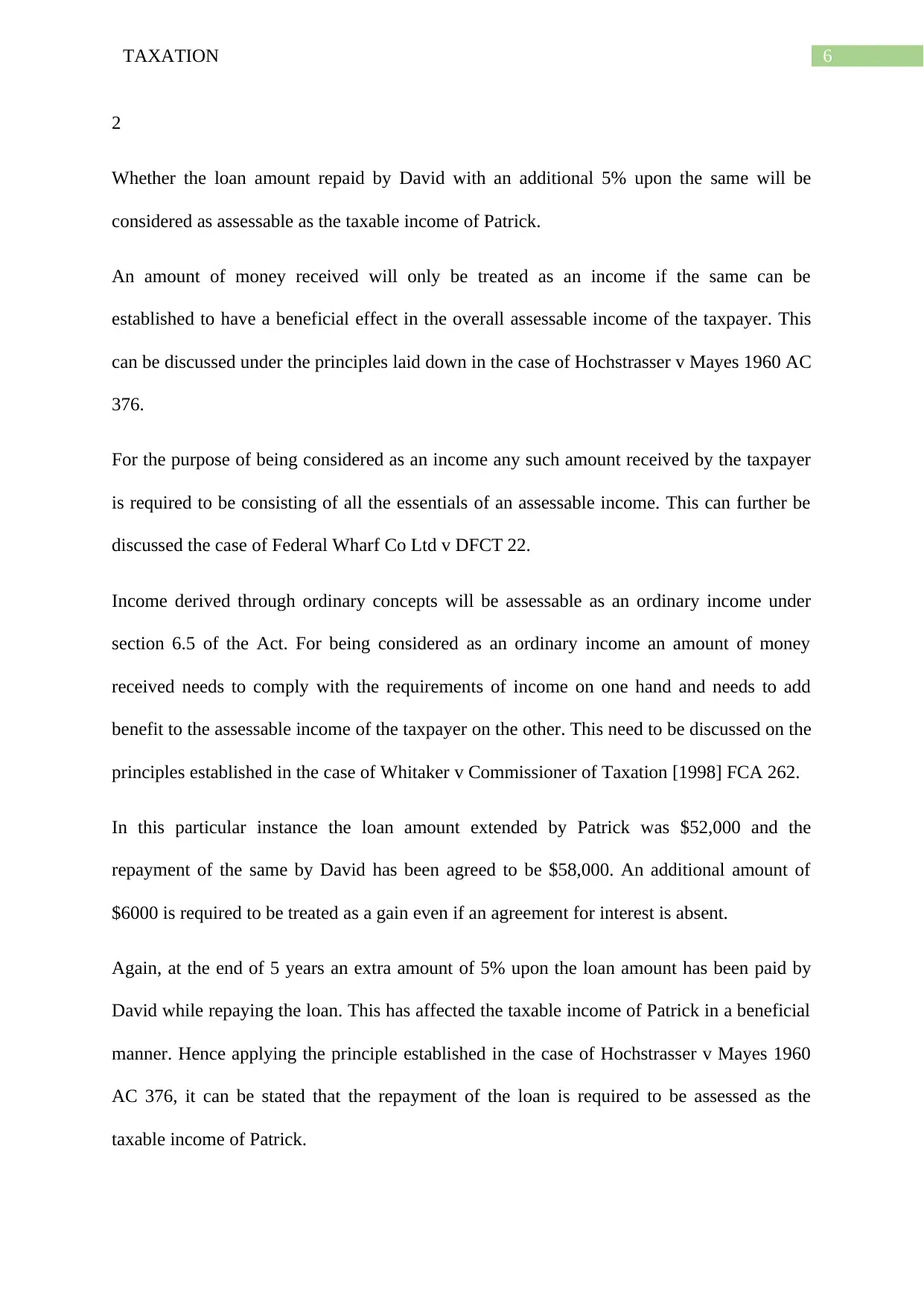
6TAXATION
2
Whether the loan amount repaid by David with an additional 5% upon the same will be
considered as assessable as the taxable income of Patrick.
An amount of money received will only be treated as an income if the same can be
established to have a beneficial effect in the overall assessable income of the taxpayer. This
can be discussed under the principles laid down in the case of Hochstrasser v Mayes 1960 AC
376.
For the purpose of being considered as an income any such amount received by the taxpayer
is required to be consisting of all the essentials of an assessable income. This can further be
discussed the case of Federal Wharf Co Ltd v DFCT 22.
Income derived through ordinary concepts will be assessable as an ordinary income under
section 6.5 of the Act. For being considered as an ordinary income an amount of money
received needs to comply with the requirements of income on one hand and needs to add
benefit to the assessable income of the taxpayer on the other. This need to be discussed on the
principles established in the case of Whitaker v Commissioner of Taxation [1998] FCA 262.
In this particular instance the loan amount extended by Patrick was $52,000 and the
repayment of the same by David has been agreed to be $58,000. An additional amount of
$6000 is required to be treated as a gain even if an agreement for interest is absent.
Again, at the end of 5 years an extra amount of 5% upon the loan amount has been paid by
David while repaying the loan. This has affected the taxable income of Patrick in a beneficial
manner. Hence applying the principle established in the case of Hochstrasser v Mayes 1960
AC 376, it can be stated that the repayment of the loan is required to be assessed as the
taxable income of Patrick.
2
Whether the loan amount repaid by David with an additional 5% upon the same will be
considered as assessable as the taxable income of Patrick.
An amount of money received will only be treated as an income if the same can be
established to have a beneficial effect in the overall assessable income of the taxpayer. This
can be discussed under the principles laid down in the case of Hochstrasser v Mayes 1960 AC
376.
For the purpose of being considered as an income any such amount received by the taxpayer
is required to be consisting of all the essentials of an assessable income. This can further be
discussed the case of Federal Wharf Co Ltd v DFCT 22.
Income derived through ordinary concepts will be assessable as an ordinary income under
section 6.5 of the Act. For being considered as an ordinary income an amount of money
received needs to comply with the requirements of income on one hand and needs to add
benefit to the assessable income of the taxpayer on the other. This need to be discussed on the
principles established in the case of Whitaker v Commissioner of Taxation [1998] FCA 262.
In this particular instance the loan amount extended by Patrick was $52,000 and the
repayment of the same by David has been agreed to be $58,000. An additional amount of
$6000 is required to be treated as a gain even if an agreement for interest is absent.
Again, at the end of 5 years an extra amount of 5% upon the loan amount has been paid by
David while repaying the loan. This has affected the taxable income of Patrick in a beneficial
manner. Hence applying the principle established in the case of Hochstrasser v Mayes 1960
AC 376, it can be stated that the repayment of the loan is required to be assessed as the
taxable income of Patrick.
Paraphrase This Document
Need a fresh take? Get an instant paraphrase of this document with our AI Paraphraser
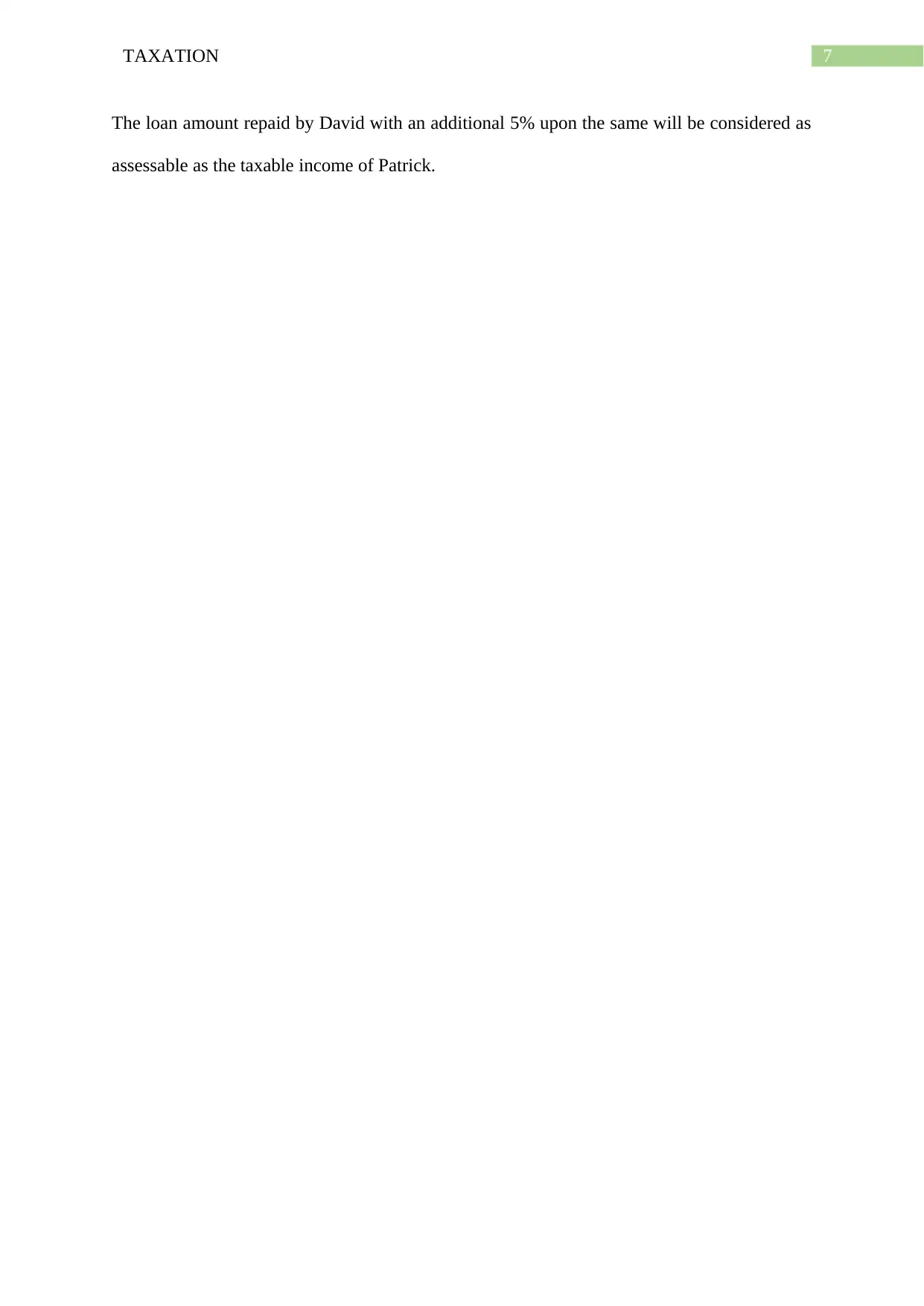
7TAXATION
The loan amount repaid by David with an additional 5% upon the same will be considered as
assessable as the taxable income of Patrick.
The loan amount repaid by David with an additional 5% upon the same will be considered as
assessable as the taxable income of Patrick.

8TAXATION
Reference
Brent v Federal Commissioner of Taxation (1971) ATC 4195
Federal Wharf Co Ltd v DFCT 22
Hochstrasser v Mayes 1960 AC 376
Housden (Inspector of Taxes) v Marshall [1958] 38TC233
Pacific Film Laboratories v Commissioner of Tax [1970] HCA 36
Tax Ruling 97/11
The Income Tax Assessment Act 1936 (Cth)
The Income Tax Assessment Act 1997 (Cth)
Tupicoff v. FCT 84 ATC 4851
Whitaker v Commissioner of Taxation [1998] FCA 262
Reference
Brent v Federal Commissioner of Taxation (1971) ATC 4195
Federal Wharf Co Ltd v DFCT 22
Hochstrasser v Mayes 1960 AC 376
Housden (Inspector of Taxes) v Marshall [1958] 38TC233
Pacific Film Laboratories v Commissioner of Tax [1970] HCA 36
Tax Ruling 97/11
The Income Tax Assessment Act 1936 (Cth)
The Income Tax Assessment Act 1997 (Cth)
Tupicoff v. FCT 84 ATC 4851
Whitaker v Commissioner of Taxation [1998] FCA 262
1 out of 9
Related Documents
Your All-in-One AI-Powered Toolkit for Academic Success.
+13062052269
info@desklib.com
Available 24*7 on WhatsApp / Email
![[object Object]](/_next/static/media/star-bottom.7253800d.svg)
Unlock your academic potential
© 2024 | Zucol Services PVT LTD | All rights reserved.





